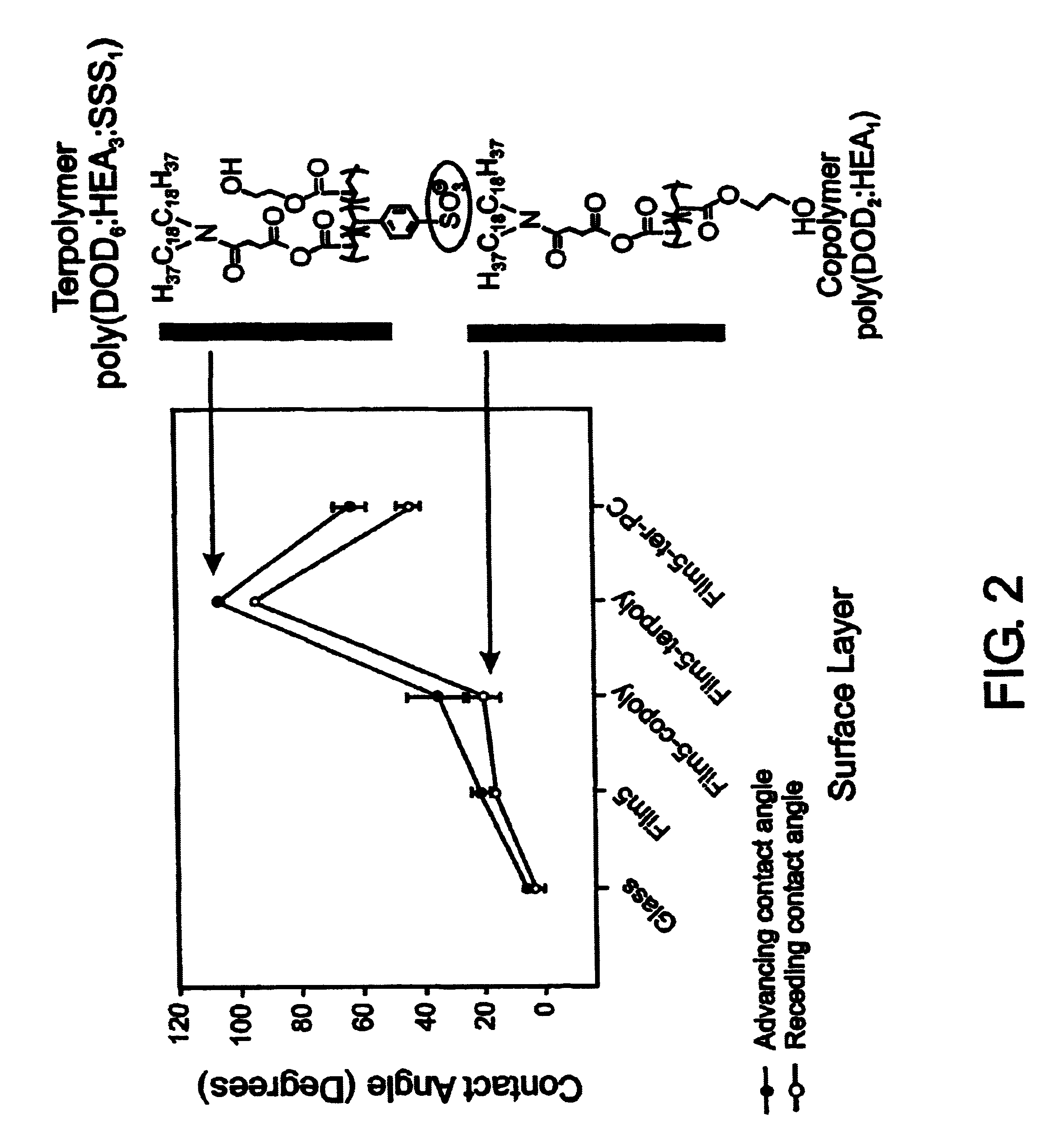Biological component comprising artificial membrane
- Summary
- Abstract
- Description
- Claims
- Application Information
AI Technical Summary
Benefits of technology
Problems solved by technology
Method used
Image
Examples
example 1
Preparation of Membrane-mimetic Film on Microbeads
[0114]Reagents. All starting materials and synthetic reagents were purchased from commercial suppliers unless otherwise noted. Poly-L-lysine (PLL; 21-479 kD) was purchased from Sigma. Alginate (ca. 41% guluronic acid) was obtained from ISP alginate (San Diego, Calif.) and used as received. N,N-dioctadecylcarbamoyl-propionic acid (DOD), poly(HEA-DOD)6:3, 1-palmitoyl-2-(12-(acryloyloxy)dodecanoyl)-sn-glycero-3-phosphorylcholine (mono-AcrylPC), and 1-palmitoyl-2-(12-(acryloyloxydodecanoyl)-sn-glycero-3-phosphorylethanolamine-fluorescein isothiocyanate (mono-AcrylPE-FITC) were synthesized as previously described. (Marra, K. G., Winger, T. M., Hanson, S. R. & Chaikof, E. L. [1997] Macromolecules 30:6483-6488; Chon, J. H., Marra, K. G. & Chaikof, E. L. [1999] J. Biomat. Sci. Polymer Ed. 10, 95-108; Sells, T. D. & O'Brien, D. F. [1994] Macromolecules 27, 226-233; Sun, X. L., Liu, H., Orban, J. M., Sun, L. & Chaikof, E. L. [2001] Submitted t...
example 2
Cytomimetic Biomaterials: Synthesis and Analysis of Bioactive Membrane-Mimetic Structures Synthesis of Lipopeptide and Glycolipid Conjugates
[0145]Site-specific methods have been developed for the synthesis and purification of lipid-peptide and glycolipid macromolecules in the absence of complex blocking group strategies. (Winger, T. M. et al. [1995] Bioconjug. Chem. 6:323-326; Winger, T. M. et al. [1995] J. Liquid Chromatogr. 18:4117-4125; Winger, T. M. et al. [1995] Biomaterials 16:443-449; Winger, T. M. and Chaikof, E. L. [1997] Langmuir 13:3256-3259; Sun, L. and Chaikof, E. L. [1997] Bioconj. Chem. 8:567-571; Sun, L. and Chaikof, E. L. [1998] Carbohydrate Res. 370: 7-81.) Using these techniques, the orientation of the coupled peptide and carbohydrate has been maintained, which is often required for effective ligand-receptor interactions. The conjugates thus obtained are incorporated into self-assembling systems, such as lipid monolayers for behavioral studies at an air-water inte...
example 3
Stabilization of Membrane-mimetic Biomaterials: Polymerization of Lipid Macro-assemblies and Characterization of Blood Contacting Properties
[0151]In situ polymerization of phospholipids on an alkylated surface. An in situ polymerization strategy was developed using monoacrylate phospholipids as a means of stabilizing a self-assembled lipid monolayer at a solid-liquid interface (FIG. 8). (Marra, K. G. et al. [1997] Macromolecules 30:6483-6487.) Phospholipid monomer, 1-palmitoyl-2-(12-(acryloyloxy)dodecanoyl)-sn-glycero-3-phosphorylcholine, was synthesized, prepared as unilamellar vesicles, and fused onto alkylated (OTS) glass. Free-radical polymerization was carried out in aqueous solution at 70° C. using the water-soluble initiator, 2,2′-azobis(2-methylpropionamidine) dihydrochloride (AAPD) (Scheme 2). Under optimized conditions, the supported monolayer displayed advancing and receding water contact angles of 65° and 44°, respectively. Angle-dependent ESCA results confirmed the pres...
PUM
| Property | Measurement | Unit |
|---|---|---|
| Fraction | aaaaa | aaaaa |
| Percent by mole | aaaaa | aaaaa |
| Length | aaaaa | aaaaa |
Abstract
Description
Claims
Application Information
 Login to View More
Login to View More - R&D
- Intellectual Property
- Life Sciences
- Materials
- Tech Scout
- Unparalleled Data Quality
- Higher Quality Content
- 60% Fewer Hallucinations
Browse by: Latest US Patents, China's latest patents, Technical Efficacy Thesaurus, Application Domain, Technology Topic, Popular Technical Reports.
© 2025 PatSnap. All rights reserved.Legal|Privacy policy|Modern Slavery Act Transparency Statement|Sitemap|About US| Contact US: help@patsnap.com



